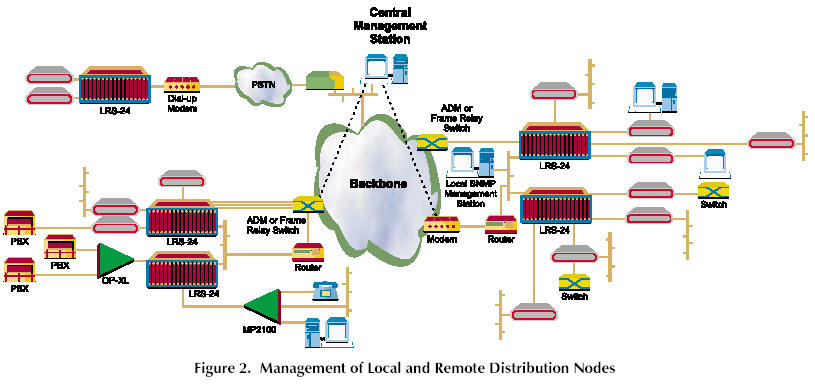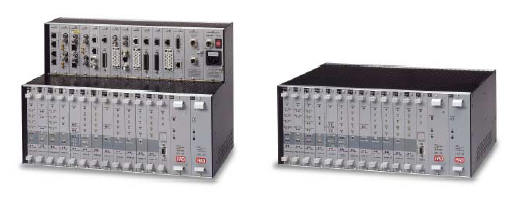|
FEATURES
-
High density modem rack
accommodating any combination of 24 xDSL, fiber or baseband modems
-
Ease of use and low-cost
maintenance on PC or UNIX (HPOV) platform through RADview SNMP management
-
Supports ASCII terminal or
remote management
-
Supports fiber and copper modems
in a single chassis for equipment and operation cost saving
-
A wide range of data rates from
1.2 kbps up to 45 Mbps, for easy and cost effective migration to a higher
speed on the same platform
-
A wide variety of modular data
interfaces including V.35, X.21, Ethernet and IP router
-
Single or multi IP modes for the
rack that includes the modems with built-in SNMP agent (S-Mode cards)
-
Automatic IP addressing
configuration (BootP)
-
Supports dial-up modem and dry
contacts for major alarms reporting
-
IP fragmentation support
-
Remote software download
-
Storage of up to three software
configuration files for a modem and up to two configuration files for the
modem rack
-
Remote soft reset of the Central
Management (CM-2) and quad modem cards
-
System clock provision
-
Two chassis versions, ANSI and
ETSI
-
Optional dual power supply with
full redundancy, AC or DC
-
Optional power feeding for
remote devices
-
Hot swappable cards
SPECIFICATIONS
-
LRS - 24 is high-density SNMP
managed modem hub. The chassis has 12 slots that accommodate up to 24
modems. Using modular interface cards LRS - 24 can support xDSL, fiber or
baseband modems in the same chassis under a single management application
(see Table 1).
-
Supports different modem
technologies and enables a wide range of data rates starting from 1.2 kbps
in IDSL modems through 2 Mbps in HDSL modems, and up to 43 Mbps in fiber
modems. These modem technologies enable ranges from 4.8 km at 2 Mbps over
copper to 100 km over fiber optic cables.
-
LRS - 24 is available in two
different physical hub versions:
ANSI - card insertion,
LEDs and switches are at the front, but cable connections are at the rear
of the hub. This compact, 4U high unit complies with the American ANSI
standard. Cards can be hot-swapped without removing cables.
ETSI - card insertion,
LEDs, switches and cable connections are at the front. This version is 30
cm high (almost 7U), and complies with European ETSI standard. Cards can
be hot-swapped without removing cables.
-
All cards can be replaced, or
cables removed, during operation, without causing interference to data
transmission to/from other cards in the chassis.
-
Modular data interfaces allow
modem connectivity using a wide range of data interfaces. These include
V.24, V.35, X.21, RS-530, V.36, G.703 Codirectional, E1/T1, built-in
Ethernet bridge (with or without VLAN support) and built-in IP router.
-
LRS-24 accepts a system clock
via the DB-15 connector placed on the CM-2 card and distributes the clock
to all cards.
Management/CM-2 functions
-
LRS-24 is managed by a
UNIX?based or PC-based SNMP management system via the Central Management
card (CM-2). The software is user-friendly, GUI-based and runs under
PC/Windows (RADview-PC) or HP-OpenView (RADview-HP-OV) systems. The SNMP
management session can be run over Ethernet (10BaseT or 10Base2 port) or
SLIP (RS-232 port).
-
Network management provides
centralized control of all LRS-24 hubs, modem cards and remote modems in
the network, including interface configuration, connection setup, alarm
and monitoring. A single management station can control up to 64,000
LRS-24 hubs.
-
LRS-24 can also be managed from
an ASCII terminal. It allows all functions of SNMP except for GUI
interface.
-
Telnet support enables terminal
connection over any IP network.
-
Performance information is
available in graph and table format for the last 24 hours. This
information can be saved in a file for accounting purposes.
-
If a major alarm occurs, the
LRS-24 CM-2 card can dial out through an external dial-up modem to a
central management site. This saves a direct connection to remote sites,
while providing alerts if critical events occur. In addition alarms can
activate dry contacts. The dry contacts are placed on the system clock
connector on CM-2.
-
Two types of modem cards are
available on LRS - 24:
-
S-Mode: Cards with built-in
SNMP agent. Single IP option is used to reduce the number of addresses
used by LRS - 24 and S-mode modems. With this option, only the CM-2
module is assigned an IP address; all connections to the modems are made
via CM-2.
-
I-Mode: Cards without SNMP
agent. For these cards CM-2 serves as the SNMP proxy agent. The CM-2
built-in agent complies with SNMP MIB II and supports generic SNMP HPOV
applications.
-
A new software version can be
downloaded from a remote site into the CM-2 via:
CM-2 saves up to three software
versions.
-
When the management station
includes BootP software, the CM-2 card automatically retrieves the IP
address required for management connection. This eliminates the need to
configure IP addresses for new hub installations.
-
LRS-24 supports IP fragmentation
restoring the fragmented IP data sent to the rack by the network
management station.
-
Telnet support enables terminal
connection over any IP network.
-
LRS-24 performs reset of the
remote CM-2 module or CQ modem card via the management software.
-
LRS-24 stores up to three modem
configuration files and up to two system configuration files. These files
can be copied to any media and used for backup or configuration purposes.
-
The CM-2 panel includes an
alphanumeric display with two characters, which alerts on fault conditions
during the power-up self-test. During the normal operation it displays the
last two digits of the hub number.
Power Supplies
-
LRS-24 operates with single or
dual, AC or DC power supplies. Each power supply supports a fully
populated LRS-24 hub. Redundant power supply can be replaced during
operation, without affecting system performance (hot swapping).
-
Cards of the LRS-24 chassis
enable remote power feeding for repeaters and remote standalone modems.
For this purpose, a separate power supply, LRS-PS-FEED, should be ordered
Number of Slots
 12 card slots 12 card slots
 1 slot for the
CM-2 module 1 slot for the
CM-2 module
 2 slots for
power supply module 2 slots for
power supply module
Connectors
Each card has its own connector options (for connector
types, see specific data sheet on the card)
Power Supply
AC: 100 to 240 VAC, 47 to 63 Hz, 112W
DC: -48 VDC (-40.5 to -72 VDC)
Management Connection
V.24/RS-232: DB-9, female
Ethernet: RJ-45 or coax (BNC)
System Clock
DB-15 connector
? Physical
ANSI version (B):
Height: 17.7 cm / 7.0 in
Width: 48.2 cm / 19.0 in
Depth: 32.4 cm / 12.8 in
ETSI version (F):
Height: 30.0 cm / 11.8 in
Width: 48.2 cm / 19.0 in
Depth: 25.3 cm / 9.9 in
Weight:
LRS24/AC48: 8.6 kg / 19.0 lb (one AC and one DC power
supply)
LRS24/ACR: 8.1 kg / 17.8 lb (two AC power supplies)
LRS24/48R: 9.0 kg / 19.8 lb (two DC power supplies)
LRS24/AC: 6.9 kg / 15.2 lb (one AC power supply)
LRS24/48: 7.4 kg / 16.3 lb (one DC power supply)
? Environment
Temperature: 0-45C / 32-113F
Humidity: Up to 90%, non-condensing
CM-2 CARD
? LAN Interface
Standard:
IEEE 802.3 10Base2 (BNC)
IEEE 802.3 10BaseT (UTP)
Connector: shielded RJ-45 or BNC (see Orderin g)
? Terminal Interface
Standard: V.24/RS-232
Rate: 38.4 kbps
Character: Async, 8 bits, 1 stop bit, no parity
Terminals supported: VT-52, VT-100, VT-920
Connector: D-type, 9-pin female
? Indicators
PWR (green): Power ON
TD (yellow): SNMP management transmit data
RD (yellow): SNMP management receive data
Rack indicator:
2-character display for the last two digits of the hub
number, or for alerting on system fault condition
? Physical
CM-2 main card:
Height: 158 mm / 6.2 in
Width: 20 mm / 0.8 in
Depth: 235 mm / 9.2 in
Weight: 350g / 12.3 oz
CM-2 interface module:
Height: 103 mm / 4.1 in
Width: 20 mm / 0.8 in
Depth: 93 mm / 3.7 in
Weight 110g / 3.8 oz
? Power
5W
? Environment
Temperature: 0-50 C / 32-122 F
Humidity: Up to 90%, non-condensing
ORDERING
LRS-24/CM2-VER2.5
LRS-24B-CM2/UTP
LRS-24B-PS/AC
LRS-24B/48/CM2/UTP
LRS-24B/48/R/CM2/UTP
LRS-24B/48R/CM1
LRS-24B/AC/48/CM2/UTP
LRS-24B/AC/CM2/UTP
LRS-24B/AC/R/CM2/UTP
LRS-24B/PS/48
APPLICATIONS

|

